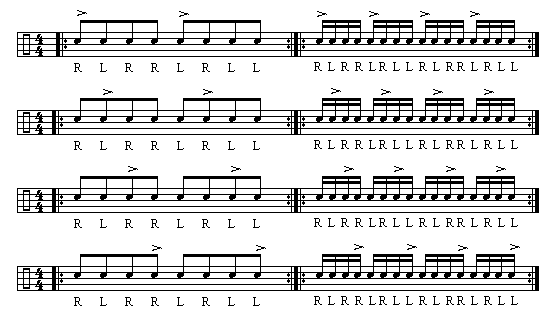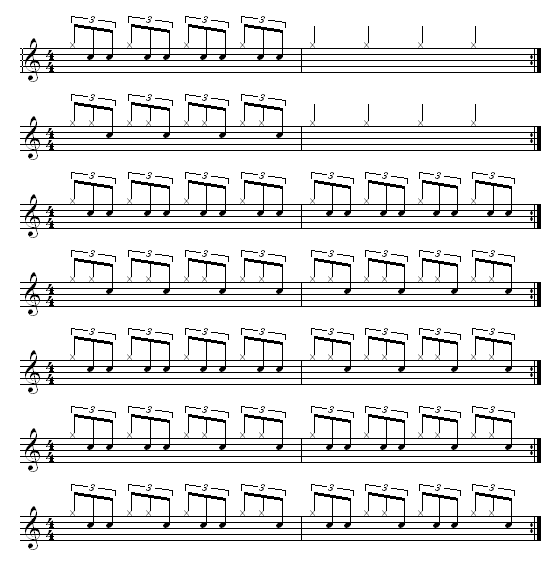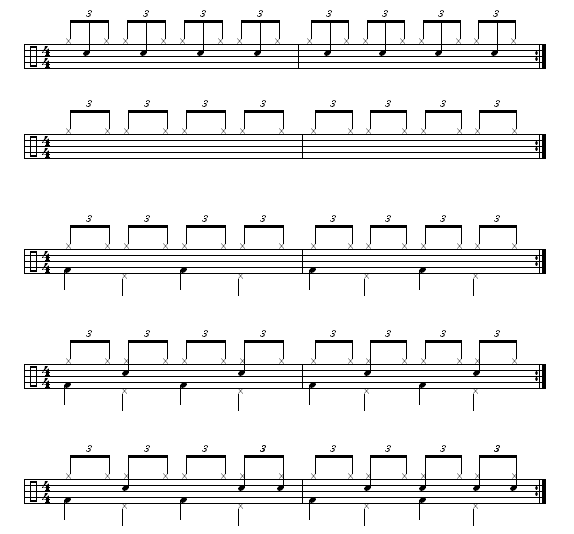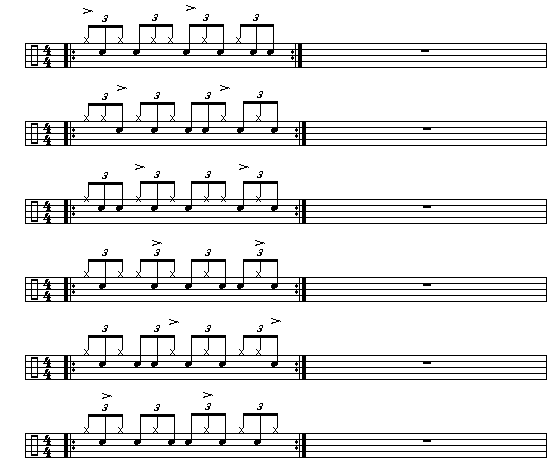The Little Drum and Percussion Page
Practice and Exercises


The
Five Stroke Roll
The five stroke Roll is one of the most commonly applied rudiments and can be used to help develop the bouncing of the sticks. It should be practiced so that the stick bounces cleanly to make two consecutive beats that are equally spaced with the two beats on the other hand then the last single stroke is accented. The sticking is RRLLR LLRRL. When you can play it with the groups of five beats equally spaced work on the speed of it. Keep time with your right foot and when it gets too fast, just play one and three with your foot.
When you have conquered the Five Stroke Roll, do the same with the Seven stroke Roll. It's likely that you will always be playing these in some form in your practice regeime. the next step is to start mixing up with five and seven stroke rolls.
These exercises come from my old departed teacher, drum giant and master, Jack Peach. If you haven't already had a look at the page I keep about him roll over and have a look.
You will also see some of these excersises recommended in Giovanni Hidalgo's superb Conga instruction videos available from Knock On Wood.

Seven Stroke Roll
In the same fashion develop the seven stroke roll.

Five and Seven Stroke Roll
Then add the two together just like Jack Peach, Phil Seaman and other great British drummers of yesteryears,

The
Single Paradiddle
First try the
single paradiddle with the accent on the first beat of each group. Then with
the accent on the second beat of each group and so on (gets more difficult).

Practice them in time playing one and three on your bass drum or hi hat.
Triplets
A Triplet is, in effect, a beat that is split into three equally spaced beats. The word triplet is sometimes used phonetically in counting triplets so that (in four/four time) the quarter notes made into triplets wouldsound like this,
ONE-trip-let TWO-trip-let THREE-trip-let FOUR-trip-let.
The following triplet exercises are very useful for improving the speed of your hands. Especially the 'weak hand'.
The notes written on the cymbal line, are all right handed notes. The notes written on the snare drum line, are all left hand notes. This makes it easier to follow the exercises written below. Although they are written on cymbal and snare drum lines, you can play them all on the same instrument.
You can practice the patterns on the snare drum or practice pad to improve your speed.
There are two triplets A and B. The hand sequence of Triplet A is Right Left Left. The hand sequence of triplet B is Right Right Left.

a's and b's by Jack Peach
The first two exercises contain a bar of triplets and
a bar of quarter note taps played by the right hand.
This set of exercises are extremely helpful in developing your "long roll".
The Shuffle Rhythm
From here you can easily develop the popular and widely used 'Shuffle' rhythm.
The sticking of this triplet is - Right Left Right. If you repeat the triplet and leave out the left hand you have the shuffle that is played on the cymbal (or on the snare drum with a brush and sometimes a stick).

Triplet Paradiddle Exercises
Expanding on the previous set of exercises here is (Courtesy of Jack Peach) a set of triplet paraddiddles. As with the other exercises, REPEAT the phrases. Play each one for at least a couple of minutes when practising. Although they are written on cymbal and snare drum lines, play them all on the snare drum. They are written this way so beginners can see easily the strokes for right and left hands.
Where the a's and b's are good for your roll these paradiddlies will really help you 'mix it up' as Jack used to say.
Remember the accent always comes after the double strokes.

Drags
The Drag is one of the most useful and cool sounding of the 26 drum Rudiments and that is why it is included here. The main notes in the phrae are preceeded by two "Grace Notes" which are the pair of small sixteenth notes placed before the first main note and played very closely together. The first exercise is a simple Drag with quarter notes and the second is a drag paradiddle which is useful to practice the Drag 'hand to hand'.


Flams
An easy way to master Flams is to practice them as triplets, hand to hand. So here is a Flam Triplet exercise. Study Triplets first if you need to (see Exercises page).
The first exercise has both hands playing the first beat of each triplet at the same time. This is to assist you in mastering the sequence. The second exercise contains the proper flam where the Grace note is played slightly before the main first beat of the triplet. Make sure that you begin each triplet with the hand that is going to play the main note (ie the note following the Grace note), in a higher starting position. At first exaggerate the height of this accent hand and, as you master the sequence, gradually reduce it so the main note hand is only slightly higher before beginning playing the triplet.

I hope you find some of what is here useful. If you have any questions, e-mail me. The site is constantly being developed so come back soon to check for more exercises and patterns.
E-mail phil@littledrum.co.uk
All material on this site is copyright Phil Little 2000